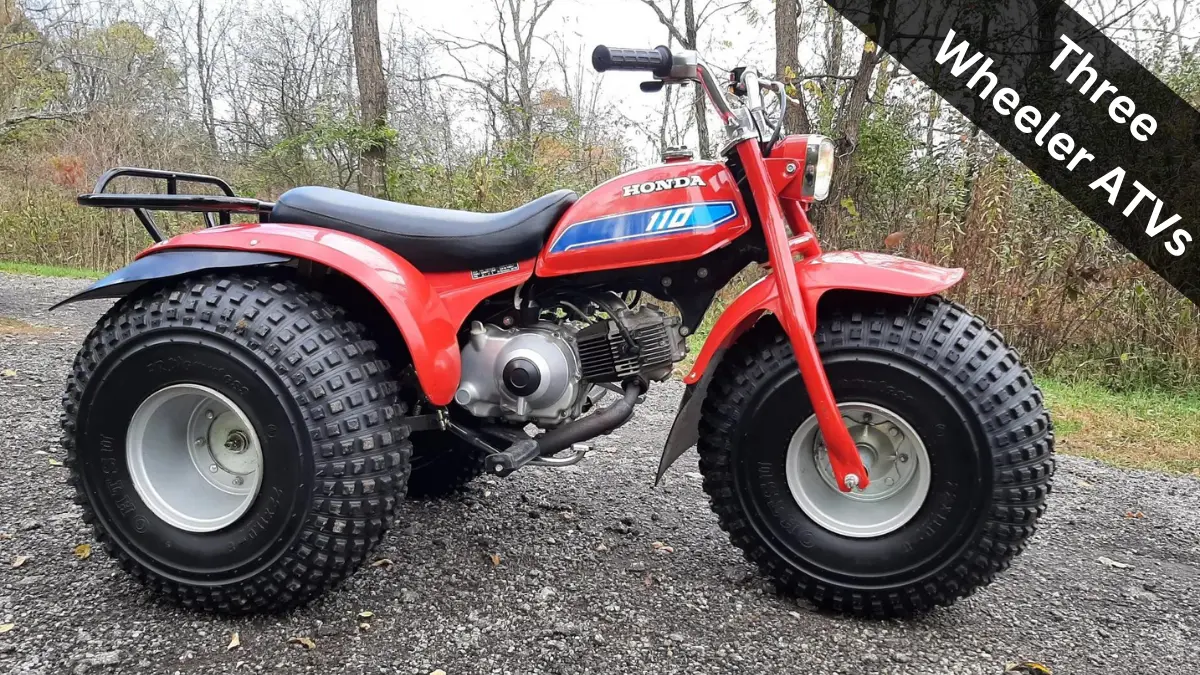While four wheel ATVs have experienced an explosion in popularity over the last few decades, it’s easy to overlook the fact that the three wheeler ATVs that preceded them were on the same trajectory in the 1970’s and 80’s.
That is, until they were banned.
But there are still plenty of these three wheeler ATVs around today, and if they interest you for whatever reason, you’ve come to the right place.
This guide will explore the following:
- Why three wheeler ATVs were banned
- Whether or not they’re truly dangerous
- Injuries and deaths attributed to three wheelers
- Whether you can still legally buy them
- Brief overview of the most popular ATV models and manufacturers
The Rise And Fall Of The 3 Wheeler ATV
Three wheeler ATVs got their start in 1967, with the first ever model released by Sperry Rand, a small manufacturer at the time. The first model was called the Sperry Rand Tricart ATV.
Just three years later, Honda released their own model and the Sperry Rand Tricart essentially went poof. Eventually, the likes of Yamaha, Kawasaki, and Suzuki would all join the three wheeler party.
As smaller vehicles, three wheelers were initially marketed towards younger riders who were drawn to the fun factor they provided.
But over the next few years their popularity grew among adults as well, as both outdoor enthusiasts and working folk realized the value in owning a small vehicle that could carry them around their properties or trails.
No more saddling up a horse to check on fences and animals around the farm, or needing to walk to a favorite backwoods hunting spot.
From around 1975 to 1987, you could find three wheel ATVs all over the place. Their popularity was soaring and continued to rise each year among riders of many different ages and types.
But 1987 would mark the last year of their production, as the reign of three wheelers came to a crashing halt in 1988 when they were banned.
Why Were 3 Wheeler ATVs Banned?
After numerous reported injuries and deaths, many of them to children, it seems that ATV manufacturers saw the writing on the wall that a change was to come.
Injuries & Deaths
There were reportedly close to 300,000 injuries and 1,000 deaths attributed to ATVs from the time of their initial release to their banning in 1988.
The most commonly reported injuries and deaths among three wheelers were:
- Head injuries after being ejected and hitting a tree or being rolled over by the vehicle
- Internal injuries suffered after being ejected from the vehicle and being rolled over on by the vehicle
- Severe neck injuries and broken necks after flipping the vehicle
- Leg injuries from rear tires rolling up on legs
These injuries and deaths are all tragic, especially as many of them happened among youths. But it’s also important to consider the context of many of these incidents.
When reading through the incident reports provided by the US Consumer Product Safety Commission, there are some common themes among the overwhelming majority of them.
- Not wearing a helmet or any safety gear
- Reckless driving
- Collision with a vehicle
- Alcohol
Point being, the perceived dangers with the design of these three wheeler ATVs was generally not the cause of most of these reported incidents.
Here are just a few of the many examples of this:
- Two adult males, ages 41 and 39, died in Wisconsin after drowning when they rode their three wheeler across a frozen lake and it fell through the ice.
- A 12 year old and 20 year old from Texas, one riding a three wheeler and one riding a two-wheel dirt bike, both died from head and neck injuries after colliding head-on while playing “chicken”. Neither wore helmets.
- A 13 year old Oregon boy died of blunt force trauma to the head after his three wheeler collided with a pickup truck while riding on the wrong side of a private dirt road.
- A 26 year old Georgia woman died when a three wheel ATV she was driving up a ramp in an attempt to load it into a truck flipped over and landed on her head.
Among the reports of injury and death attributed to three wheeler ATVs, the overwhelming majority of them were similar to the examples above in that it was hard to find fault with the vehicle itself.
And again, while each of these accidents are tragic, it’s important to consider the context when deciding whether or not you believe three wheeler ATVs to be dangerous as a whole.
Lawsuits, Legislatures, & The Consent Decree
Things came to a head in 1987 when the senior managing director of Honda was compelled to testify during a personal injury trial resulting from a lawsuit of a recently injured 9-year old boy who suffered a brain injury after falling from a Honda three wheeler driven by a friend.
After the Honda director was given a list of 789 names of victims who had died in accidents involving ATVs, with almost half of them being children ages 15 years and younger, he understandably broke down and wept on the witness stand.
Shortly thereafter in 1988, manufacturers of three wheel ATVs signed a consent decree with the US government in which they voluntarily agreed to stop manufacturing three wheelers.
1987 marked the final year that new three wheelers would be produced and sold.
Why Are They Considered Dangerous?
For experienced riders who know any ATV’s limitations and don’t ride recklessly, there’s a low likelihood of wrecking or getting injured.
And while that can be said for ATVs of both three and four wheels, there are a number of factors that can be pointed to when making the case that three wheeler ATVs are dangerous.
- Poor design
- Smaller and lighter in size
- Oversized tires
- Foot pegs
Design
Firstly and most importantly, three wheeler ATVs were poorly designed in terms of safety.
With the single tire up front not providing the same stability you get from the two tires in the rear, it’s obvious this design will make the machine tippy.
If you turn the front wheel too sharply using the handle bars while the rear wheels push forward, you’ll very likely flip the machine.
This makes cornering a bit sketchy, especially for inexperienced riders who aren’t familiar with why and how you should shift your body weight when turning.
Size
As smaller, lighter vehicles with more weight concentrated in the rear than up front, even a slight pull upwards or backwards on the handlebars will produce a wheelie and can tip the three wheeler over backwards.
This problem is amplified when going up an incline, especially if on trails with uneven terrain.
The lighter front end of the vehicle also contributes to difficulty steering at high speeds and makes it more susceptible to rolling.
Tires
The oversized “balloon” tires that were initially used in place of a suspension lead to your rear end taking a real beating as they provided nowhere close to the level of stability and smoothness that any suspension system does.
But even as these balloon tires were replaced with more traditional rubber tires in 1974, you can liken riding on these still over-sized tires to riding on three basketballs with the lack of stability they provide in some terrains.
These large tires contribute to the unsteady nature of three wheelers and their increased tendency to tip or roll.
Foot Pegs
The foot pegs on either side of the vehicle where you rest your feet and use them to help balance yourself and the machine consisted of a single bar on most three wheelers.
This simplicity makes it very easy for your foot to slip off the peg. And with their compact designs, if your foot slips off the peg, there’s a good chance it will then get rolled up on and caught under the rear tire.
Some of the most common injuries seen in riders of three wheelers are leg injuries caused by the foot slipping off or missing the foot peg, ranging from bad scrapes from the tire grinding against the leg to broken bones.
Making A 3 Wheeler ATV Safer
Over the years, owners of three wheelers have found some ways to make their vehicles safer.
- Extended axles, spacers for the rear axle, or a big axle kit will extend the rear tires and improve stability.
- Add two or three gallons to the front tire to weigh it down, which helps prevent flipping.
- For units without it, adding a full suspension makes them more stable and safer.
- Replace foot pegs with bigger footwells to prevent slippage.
While any of these modifications will increase safety, simply understanding and following the basics of responsible riding and shifting body weight when turning will be the most beneficial for riders.
Can You Still Buy 3 Wheeler ATVs?
While 3 wheeler ATVs have essentially been banned from the production of new units, there are still a number of used units available for purchase today.
So you can absolutely still find them, and it is 100% legal to buy and operate used 3 wheelers today.
Let’s have a look at the main three wheelers you’ll find on the used market today.
Honda ATC
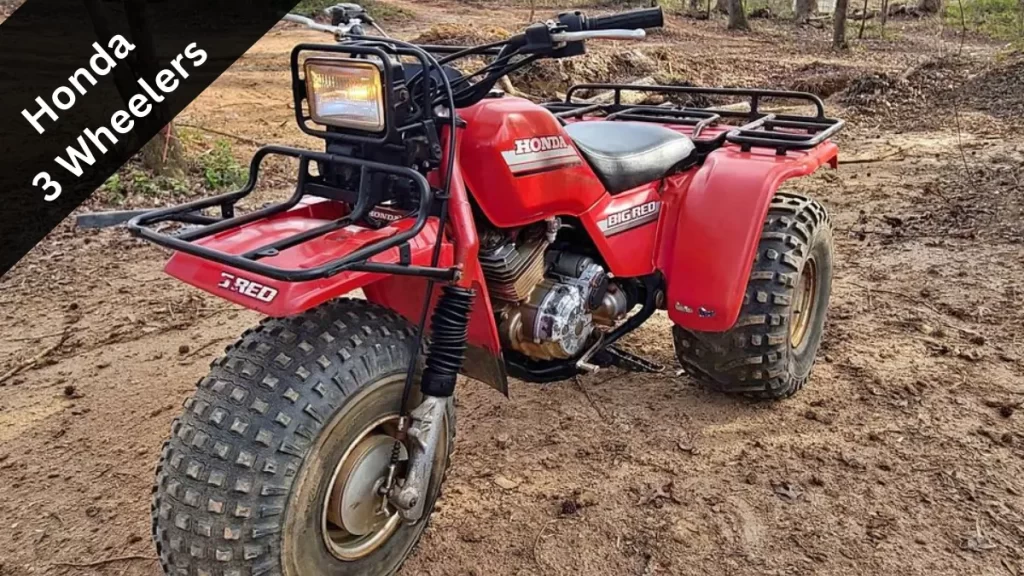
Honda was the first big-name manufacturer to enter the ATC market. They patented the design for the three-wheeler and trademarked the term “ATC”, which stands for All Terrain Cycle, so that other manufacturers were not legally able to use it.
Honda’s first ATC, the US 90, hit the market in 1970. A few years later when they trademarked the term ATC, they changed the name to the Honda ATC 90.
Aside from creating the smaller ATC 70 as their next three-wheeler in 1973, Honda would continue to go bigger and bigger from there in releasing seven more models through the end of their production in 1987.
While the engine sizes were the main differentiators between each successive model, there were also tweaks to the body styling and the eventual addition of suspension systems.
Honda also moved away from the original balloon tires in 1974 after realizing they lacked the ability to withstand prolonged abuse from rough terrain, upgrading to smaller (but still oversized) traditional rubber tires.
As Honda got the jump on the competition, they never looked back and owned the majority of the three-wheeler ATV market from 1970 through 1987.
Shortly after the ban on three wheelers, Honda shifted focus to four wheel ATVs like the Honda 300ex and Honda 400ex.
| Model | Years | Initial Price | Engine | Suspension |
| Honda ATC 90 (initially “US 90”) | 1970-1978 | $595 | 89cc, 4-stroke | None |
| Honda ATC 70 | 1973-1974, 1978-1985 | $549 | 72cc, 4-stroke | None |
| Honda ATC 110 | 1979-1985 | $898 | 105cc, 4-stroke | None |
| Honda ATC 125 | 1984-1987 | $1,198 | 198cc, 4-stroke | None |
| Honda ATC 185 | 1980-1983 | $1,248 | 180cc, 4-stroke | None |
| Honda ATC 200 | 1981-1983 | $1,298 | 192cc, 4-stroke | Front |
| Honda ATC 250 | 1981-1987 | $1,695 | 248cc, 2-stroke | Front/Rear |
| Honda ATC 350 | 1985-1986 | $2,248 | 350cc, 4-stroke | Front/Rear |
Yamaha Three Wheelers
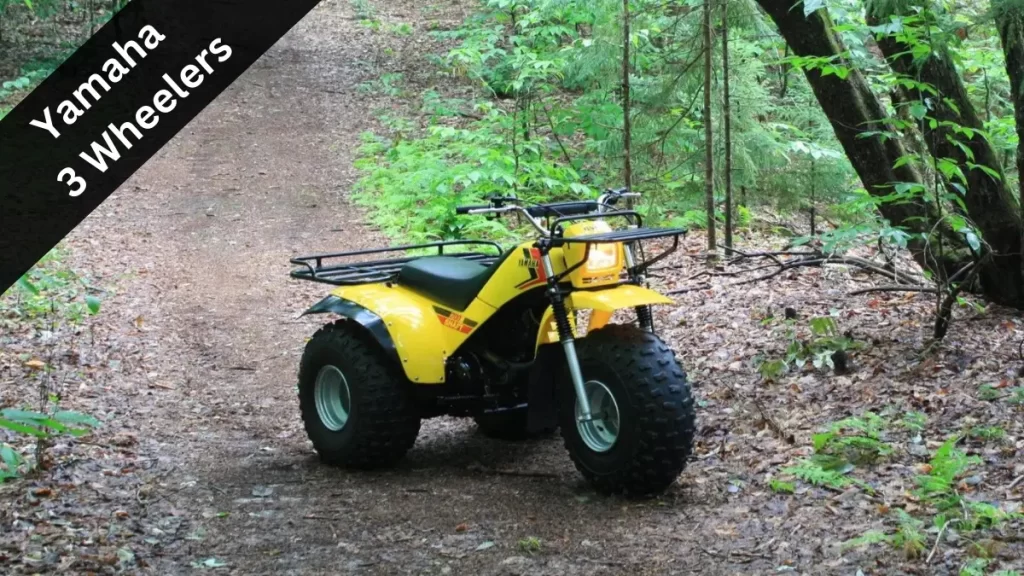
Yamaha was the second of the big-name manufacturers to enter the market for three-wheelers. They did so in 1980, with the introduction of the Yamaha YT 125 Tri-Moto.
Their design moved the engine back further and reduced the weight in comparison to Honda’s, making their three-wheelers even tippier.
While they saw success with this first model, Honda continued to dominate the market. So Yamaha tried to set themselves apart two years later with the introduction of the YT 175 Tri-Moto, the first three-wheeler equipped with a front suspension system.
While this was successful in making the model a hit among consumers and slightly eating into Honda’s market share, Honda and other manufacturers took notice of the success and introduced their own models with suspension systems just a year later.
But Yamaha continued to innovate, moving to a full suspension system with the introduction of their YTM 225 model in 1983.
Yamaha also introduced the first full sport three-wheeler in the Tri-Z 250 in 1986 to the delight of racing enthusiasts.
| Model | Years | Initial Price | Engine | Suspension |
| YT 125 Tri-Moto | 1980-1985 | $1,049 | 123cc, 2-stroke | None |
| YT 175 Tri-Moto | 1982-1983 | $1,299 | 171cc, 2-stroke | Front |
| YTM 200 Tri-Moto | 1983-1985 | $1,399 | 196cc, 4-stroke | Front |
| YTM 200 Yamahauler | 1983-1984 | $1,449 | 196cc, 4-stroke | Front |
| YTM 225 Tri-Moto | 1983-1985 | $1,849 | 223cc, 2-stroke | Front/Rear |
| YT 60 Tri-Zinger | 1984-1985 | $599 | 59cc, 2-stroke | Front |
| Tri-Z 250 | 1986-1986 | $2,249 | 246cc, 2-stroke | Front/Rear |
Kawasaki Three Wheelers
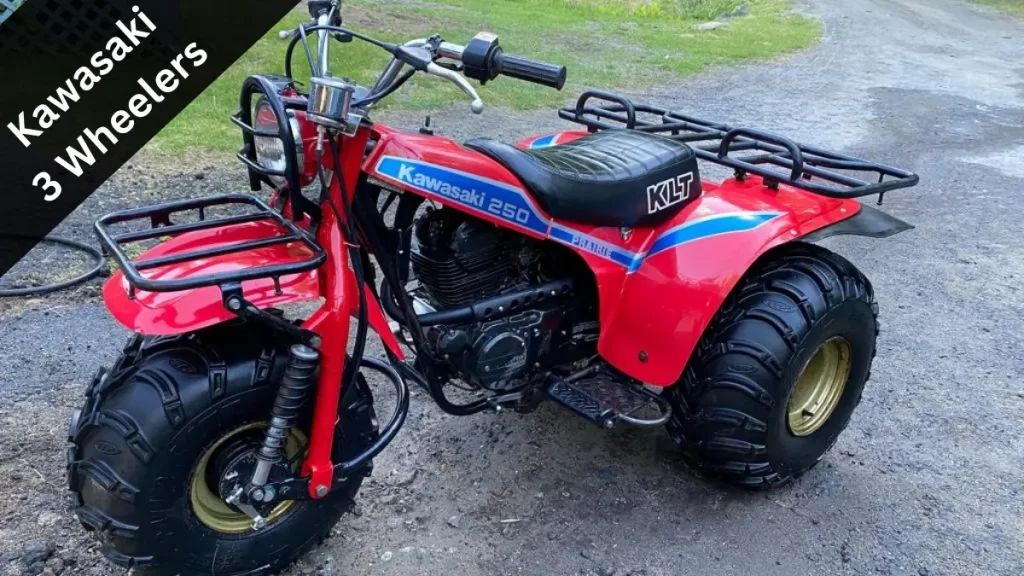
Kawasaki was next to join the three-wheeler party, with the introduction of their first model in the Kawasaki KLT 200 in 1981.
Seeing the popularity of these machines among farmers and hunters, Kawasaki’s initial three-wheeler models were geared towards these folks with the KLT 200’s 198cc engine being the biggest in the industry.
But this was short-lived, as Honda overtook them the following year.
For those familiar with the Kawasaki’s popular line of Prairie four wheelers, the first ever Kawasaki Prairie was a 249cc three-wheeler introduced in 1983.
Eventually, Kawasaki pivoted to include a more family-focused model in the KLT 110 that was geared towards smaller riders more interested in using three-wheelers for recreational trail riding than work.
They made several upgraded but similar models shortly thereafter as well, and adapted along with the rest of the industry to include suspension systems on some of their models.
| Model | Years | Initial Price | Engine | Suspension |
| KLT 200 | 1981-1984 | $1,399 | 198cc, 4-stroke | None |
| KLT 250 | 1982-1983 | $1,669 | 246cc, 4-stroke | Front |
| The Duckster 200 | 1983 | $1,499 | 198cc, 4-stroke | None |
| Prairie 250 | 1983-1985 | $1,549 | 249cc, 4-stroke | Front |
| KLT 110 | 1984-1986 | $899 | 103cc, 4-stroke | None |
| Tecate 250 | 1984-1986 | $1,699 | 249cc, 2-stroke | Front/Rear |
| KLT 160 | 1985 | $1,399 | 153cc, 4-stroke | Front |
| KLT 185 | 1986-1987 | $1,449 | 182 cc, 4-stroke | Front |
Suzuki Three Wheelers
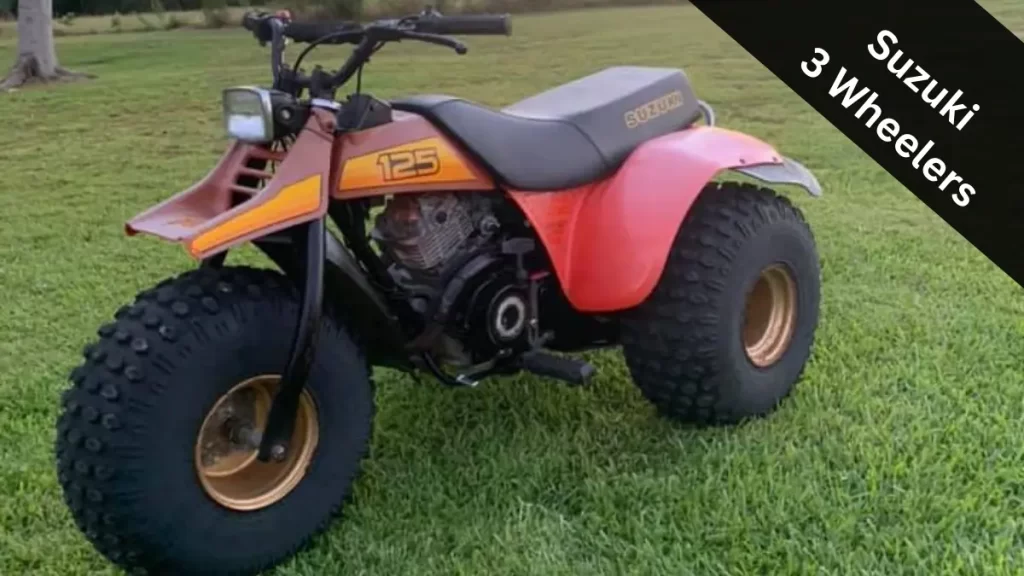
Suzuki was the last of the big-name manufacturers to enter the three wheeler ATV market, and only offered three different models since they entered just before the ban in 1988.
As such, Suzuki three-wheelers are much less common due to the overall smaller numbers they produced.
Their first three-wheeler was the Suzuki ALT 50 Trail Buddy, which was the smallest three-wheeler ever produced.
As such a small model geared towards younger riders, it was equipped with a safety tether that would kill the engine if disconnected.
The other two Suzuki three wheelers were more geared towards bigger riders, in the Suzuki ALT 125 and ALT 185.
| Model | Years | Initial Price | Engine | Suspension |
| ALT 50 Trail Buddy | 1983-1984 | $499 | 49cc, 2-stroke | None |
| ALT 125 3×6 | 1983-1986 | $1,000 | 124cc, 4-stroke | None |
| ALT 185 | 1985 | $1,299 | 178cc, 4-stroke | None |
Conclusion
While three wheeler ATVs were banned, there are still plenty of used models around today.
If you’re the owner or potential owner of one, hopefully this guide has helped you consider whether or not these vehicles are rightly deemed as being dangerous.

